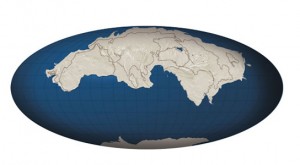Asia and America will collide in a few years – say Yale researchers
Wednesday, February 15th, 2012 6:03:39 by Taimoor Tariq
In an amazing research carried out by a geologists from Yale University in New Haven Connecticut, world’s two biggest continents, Asia and America will collide and form a single landmass around the North Pole.
However, there’s no reason to worry about it as this event is still 50 or even 200 million years away. Just like what happened 300 million years ago, the scenario will be repeated.
This was deduced by the Yale researchers through a computer model which emulates the slow movements of continents over the next millions of years. The continents, like clouds, are always in motion and will collide eventually.
The last time a supercontinent was formed was 300 million years ago in an event that resulted in the birth of the Pangea. After some careful study of the geology of mountain ranges all over the world, the geologists have deduced that Pangea will happer all
over again and a new supercontinent will be created either close to the Atlantic Oncean or somewhere in the middle of the Pacific Ocean.
However, Ross Mitchell, a geologist at Yale University in New Haven, Connecticut, and his colleagues have other ideas. They analyzed the magnetism of ancient rocks to work out their locations on the globe in the past, and measured how the mantle moves the
continents that float on its surface. They discovered that instead of staying near the equator, the next supercontinent would form over the Arctic.
The previous supercontinent was the Rodinia that was formed almost 2 billion years ago.
Geologists have already chosen a name for the supercontinent. They are calling it Amasia which will be situated 90 degrees from where the Pangea was located.
Scientists are calling this model orthoversion which is contrary to introversion where a supercontinent forms exactly where the Pangea used to be or would move on the other side of the planet.
Orthoversion clears up a conundrum that has been on geologists’ minds for decades since it models where the next supercontinent will be placed. The other possible future supercontinents were
Pangea Ultima and
Novopangea.
Short URL: https://www.newspakistan.pk/?p=12845


















A few years, 200 million years – close enough for Pakistani headline writers, I guess.
“in a few years”, Hunh? Bizarre and cheap publicity stunt.